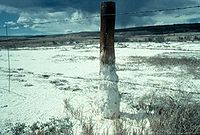
Photo from wikipedia
Portulaca oleracea L. (known as purslane) is one of the most nutritious leafy vegetables owing to its high content of antioxidants. In this study, all plants were grown indoors hydroponically… Click to show full abstract
Portulaca oleracea L. (known as purslane) is one of the most nutritious leafy vegetables owing to its high content of antioxidants. In this study, all plants were grown indoors hydroponically with different NaCl salinities. Photosynthetic photo flux density (PPFD) at 200 μmol m−2 s−1 (12 h) was provided to all plants by LED with red:blue ratio of 2.2. Thirty days after transplanting, plants grown with100 mM NaCl had the highest productivity and the fastest leaf growth followed by those with 0, 200 and 300 mM NaCl. Grown with 300 mM NaCl, purslane had the lowest specific leaf area due to its highest leaf dry matter content and its lowest water content. All plants had similar values of leaf succulence except for those with 300 mM NaCl. Total chlorophyll and carotenoids contents were significantly higher in plants grown with 0 and 100 mM NaCl than with 200, and 300 mM NaCl. All plants had Fv/Fm ratios close to 0.8. However, electron transport rate and ΔF/Fm′ were significantly higher in plants grown with 0 and 100 mM NaCl than with 200 and 300 mM NaCl. CAM-induced purslane with 300 mM NaCl had higher non-photochemical quenching. Maximum net photosynthetic O2 evolution rate and Cyt b6f concentration were significantly lower with 300 mM NaCl compared to all other plants while all plants had similar PS II concentration. Proline concentration increased with increasing salinities. All plants had similar levels of total soluble sugars. Plants grown with 0 and 100 mM NaCl had significantly higher concentrations of NO3−, total reduced nitrogen, total leaf soluble protein, Rubisco protein, total ascorbic acid, and total phenolic compounds than with 200 and 300 mM NaCl. The highest concentrations of K, Ca, and Mg were found in purslane grown under 0 mM NaCl. Statistically, no significant differences in Fe concentrations were observed among all plants. However, salinity seems to increase Fe concentration. In conclusion, it is feasible to grow purslane under 100 mM NaCl as it is the most optimal condition to achieve higher productivity and better quality. However, the production of antioxidants may depend on not only salinity but also other growth conditions.
Journal Title: Frontiers in Plant Science
Year Published: 2021
Link to full text (if available)
Share on Social Media: Sign Up to like & get
recommendations!